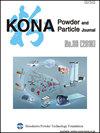NMR as a Tool to Characterize the Aggregation Structure of Silica Nanoparticles in a Liquid
IF 3.2
4区 材料科学
Q3 ENGINEERING, CHEMICAL
引用次数: 12
Abstract
The NMR-based solvent relaxation technique, a non-invasive tool to characterize the surface of particles, which are dispersed in a liquid, was applied to characterize the nanoparticles’ aggregation structure. The liquid molecules in a dispersion undergo a rapid exchange between the bound states at the interface and highly mobile free states in a bulk liquid. The relaxation time of the liquid molecules bound on the particle surface is shorter than that of the free states liquid. By detecting how much liquid is bound on the particle surface, the wetted specific surface area (SNMR) can be determined. In this study, it was clarified that the water adsorbed at more than a 1.138 layer from the silica surface can be detected by the NMR and the maximum limitation ranged from 2.160 and 3.336 layers. The model aggregates with an artificial solid neck among the particles were mixed with the silica nanoparticle dispersion. Although the determined SNMR was underestimated compared to SBET from gas adsorption, even a low ratio (5 mass%) of the model aggregates in the dispersion can be detected.核磁共振作为表征液体中二氧化硅纳米颗粒聚集结构的工具
基于核磁共振的溶剂弛豫技术是一种非侵入性表征分散在液体中的颗粒表面的工具,用于表征纳米颗粒的聚集结构。分散液中的液体分子在界面处的束缚态和散装液体中高度流动的自由态之间进行快速交换。结合在粒子表面的液体分子的弛豫时间比自由态液体的弛豫时间短。通过检测颗粒表面有多少液体结合,可以确定湿润比表面积(SNMR)。在本研究中,明确了核磁共振可以检测到从二氧化硅表面吸附在1.138层以上的水,最大限制在2.160和3.336层之间。模型聚集体与纳米二氧化硅分散体在颗粒间形成人工固颈。尽管与气体吸附的SBET相比,确定的SNMR被低估了,但即使在分散体中也可以检测到低比例(5质量%)的模型聚集体。
本文章由计算机程序翻译,如有差异,请以英文原文为准。
求助全文
约1分钟内获得全文
求助全文
来源期刊

KONA Powder and Particle Journal
工程技术-材料科学:综合
CiteScore
8.40
自引率
4.90%
发文量
35
审稿时长
>12 weeks
期刊介绍:
KONA publishes papers in the broad field of powder science and technology, ranging from fundamental principles to practical applications. Papers describing technological experience and critical reviews of existing knowledge in special areas are also welcome.
 求助内容:
求助内容: 应助结果提醒方式:
应助结果提醒方式:


